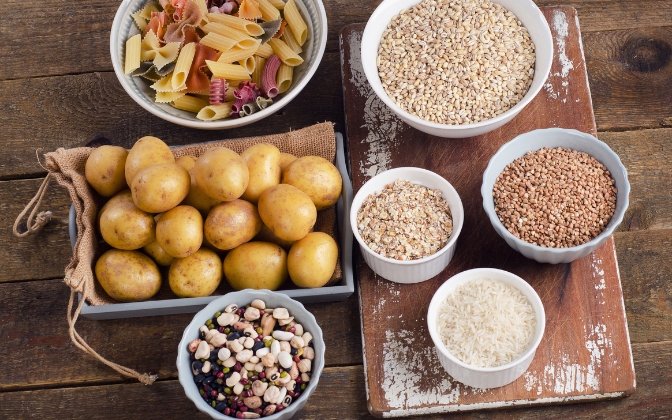Hearing your doctor say your A1C number is high can feel like a gut punch. I know because I've been there.
My “wake-up call” was a double diagnosis: Type 2 Diabetes and high blood pressure. My A1C was 7.8%, and I was terrified. As a 42-year-old mom of three, my first thought was about all the family dinners and birthday parties I'd have to miss out on.
But here's the good news I learned as I dug into the research (that's the B.S. in Computer Science in me, I love data!): your A1C number is not permanent. It's a 3-month average[1], and you have incredible power to change it.
I learned there are powerful, natural ways to lower A1C that don't involve a joyless, restrictive life. It’s about making smart, doable lifestyle changes. These are the 5 strategies that made the biggest difference for me, helping me drop 50 pounds and get my A1C down to 6.1%.
What is A1C, Anyway? (And Why It Matters)
Think of your A1C as a “loyalty card” for sugar. When sugar travels in your blood, it sticks to your red blood cells. The A1C test measures what percentage of your red blood cells are “sugar-coated” (the official term is glycated hemoglobin).
Since red blood cells live for about 3 months, the test gives you a long-term average, not just a snapshot like a finger-prick test.
According to the ADA Standards of Care (Diagnosis & Classification)[2], diabetes may be diagnosed using A1C or plasma glucose criteria (fasting plasma glucose or a 2-hour value during a 75-g OGTT); A1C is also used for ongoing monitoring.
My 5 Favorite Natural Ways to Lower A1C
When I started, I was overwhelmed. As a busy mom, I couldn't spend hours at the gym or cook three separate meals (one for me, one for my husband Mark, and one for the kids). These are the lifestyle changes to lower A1C that I could *actually* stick with.
1. Focus on Fiber (Especially Soluble Fiber)

I used to think all “carbs” were the enemy. The data taught me that the real hero is fiber.
There are two types, but soluble fiber[3] is a rockstar for blood sugar. It dissolves in water to form a gel-like substance in your gut. This “gel” physically slows down how fast your body absorbs sugar from your food.
Here's the deal: This means no more massive, post-meal blood sugar spikes. Research from the NIH-indexed literature[3] confirms that a high-fiber diet is strongly linked to improved glycemic control.
How to do it (the busy mom way):
- Add a tablespoon of chia seeds or ground flaxseed to your morning yogurt or oatmeal.
- Swap white bread for a 100% whole-grain bread that lists at least 3-4g of fiber per slice (check the FDA Nutrition Facts Label[4]!).
- Add a can of black beans (rinsed) to your next taco night.
2. Get Smart About Carbs (Not ‘No Carb')

As a mom, cutting out carbs completely is just not realistic. We have pizza nights! My kids love pasta. I refused to accept a life without these joys.
The solution wasn't “no carbs,” it was “smart carbs.” It’s about two things: the type of carb and what you pair it with.
Your body digests a cupcake *way* faster than it digests a sweet potato. This is called the Glycemic Index (GI)[5]. We want to choose lower-GI foods more often, as they cause a slower, gentler rise in blood sugar.
But the real trick? Never eat a “naked” carb. Always pair your carbohydrate with a protein and a healthy fat[6]. That apple? Eat it with a handful of almonds or a spoonful of peanut butter. The fat and protein act like a brake, slowing down sugar absorption.
This is such a key concept that I wrote a whole guide on it. You can read more about 3 simple tricks to help balance blood sugar after eating carbs.
3. Move Your Body (Even for 10 Minutes)

When I was first diagnosed, I was also struggling with chronic back pain and posture issues. The idea of an intense gym workout was intimidating and, honestly, painful.
So, I started small. I just… walked. Specifically, I started walking for 10-15 minutes right after dinner.
Here’s what's happening: When you exercise[7] (even just walking!), your muscles become more sensitive to insulin and take up glucose for fuel; this can lower blood sugar for hours after you're done.
A short walk after your largest meal[8] is one of the most effective ways to reduce A1C levels. No gym membership required.
4. Prioritize “Smart” Foods That Work For You

This isn't just about avoiding foods; it's about adding foods that actively help. As a researcher, I went looking for the data on what to add to my plate.
What I found were things that are easy to get at any grocery store, like leafy greens, fatty fish (like salmon), nuts[9], and even spices like cinnamon. These foods are packed with nutrients that can improve insulin sensitivity and fight inflammation.
I compiled my research into a list of my favorites. If you're building your grocery list, you might find my article on 12 foods that lower blood sugar for diabetics really helpful.
5. Manage Your Stress (Yes, Really)

This was the hardest one for me. Between the kids' schedules, work, and my new health anxiety, I was a wreck.
But stress isn't just “in your head.” When you're stressed, your body releases a hormone called cortisol. Cortisol's job is to get you ready for “fight or flight,” so it tells your liver to dump stored sugar (glucose) into your bloodstream for quick energy.
If you're stressed all the time (like, say, a busy mom), your blood sugar is always high, and your A1C will reflect that. Healthline confirms this direct link between chronic stress and elevated glucose.
You can't eliminate stress. But you can manage your response to it. For me, this meant 5 minutes of guided breathing on a free app, taking a hot bath after the kids were in bed, or just saying “no” to one extra commitment.
Important Safety Guardrails (Please Read)
This is critical. These tips are powerful, but they are not a replacement for medical advice or medication.
Who this is NOT for: If you are currently taking insulin or other blood sugar-lowering medications (like sulfonylureas), you must talk to your doctor before making big changes. Increasing exercise or cutting carbs can cause your blood sugar to drop too low (hypoglycemia[10]), which is very dangerous.
Your doctor needs to be your partner. They can help you make these changes safely, monitor your progress, and adjust your medications as your A1C improves. My doctor was my biggest cheerleader!
The Bottom Line: Small Steps, Big Results
When I saw that 7.8% on my lab report, I thought my life was over. But these five small, consistent steps helped me lower blood sugar naturally and take my life back.
It wasn't about perfection. It was about consistency. Focusing on fiber, getting smart with carbs, moving my body (even gently), adding helpful foods, and managing my stress response changed everything.
It's about progress, not perfection. You can do this.
Summary and Your Next Step
Lowering your A1C naturally is possible. It comes down to consistent, small habits:
1. Eat more fiber, especially soluble fiber.
2. Pair carbs with protein and fat.
3. Move your body, especially after meals.
4. Add smart foods that fight inflammation.
5. Manage your stress response.
What’s the one small change from this list that feels most doable for you this week? Let me know in the comments below. We're all in this together!
Disclaimer: This article is for informational and educational purposes only, based on my personal research and experience. It does not constitute medical advice. Always consult with your doctor or a qualified healthcare provider before making any significant changes to your diet or health routine.



References
- NIDDK: A1C Test↩︎ Back to text
- ADA Standards of Care – Diagnosis & Classification↩︎ Back to text
- Soluble Fiber & Glycemic Control (PubMed)↩︎ Back to text
- FDA Nutrition Facts Label↩︎ Back to text
- About the Glycemic Index↩︎ Back to text
- Protein/Fat Pairing & Postprandial Glucose (Review)↩︎ Back to text
- Exercise & Insulin Sensitivity↩︎ Back to text
- Post-meal Walking & 24-h Glycemia (Diabetes Care)↩︎ Back to text
- Nut Consumption & Metabolic Health (Meta-analysis)↩︎ Back to text
- Glycemic Goals & Hypoglycemia (ADA)↩︎ Back to text




